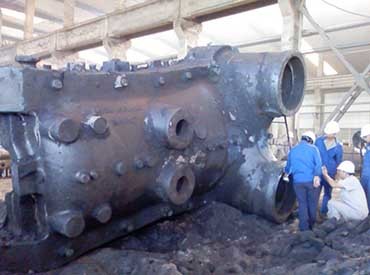Steel Casting
Release time:
2024-04-08
Source:
Current Situation of Large Steel Castings
In recent years, China's foundry enterprises have continuously increased investment, new construction, expansion or technological transformation of steel casting workshops, and adopted and applied new processes and technologies, especially the improvement of large steel casting molding and core making technology, so as to improve the production level of large steel casting products, so as to meet the growing demand of national economic growth for large steel castings.
Molding and core making process play a very important role in casting production. If the process selection is not appropriate, it may have a great impact on the quality, production efficiency and production cost of castings, such as the obvious increase of crack defects in castings and poor collapsibility of old sand. Therefore, selecting the appropriate production process is particularly important for improving the quality of casting products, improving production efficiency, reducing production costs and improving labor conditions.
At present, the molding processes available for steel castings production, especially for large steel castings, mainly include sodium silicate sand process, resin sand process, etc.

Application of Fused Ceramic Sand in Large Steel Castings
Large and medium-sized steel castings are usually coated with chromite surface sand at the hot spot during molding to improve the surface quality of castings. Now, fused ceramic sand can be used to replace chromite sand, which can not only improve the surface quality of castings, but also greatly reduce the production cost, and is also conducive to the regeneration and reuse of old sand.
Performance Description of Fused Ceramic Sand
1. Fused ceramic sand is a neutral material with compact structure, high thermal conductivity, high temperature stability, no cracking, acid and alkali resistance, and does not change under the action of various metals.
2. Major Parameters of Fused ceramic sand
Shape: Sphere
Angle Factor: ≤1.1, very spherical
Bulk Density: 1.95-2.05 (g/cm3)
Refractoriness: ≥1790℃
Thermal expansion: 0.13% (10 minutes at 1000℃)
3. Chemical Properties of Fused Ceramic Sand
Chemical stability, acid and alkali resistance.
Requirements of Fused ceramic sand for binder: it can be used for acid, alkali and combination. The amount of resin added can be reduced by 30-50%, and the amount of sodium silicate added is less than 4%.
4. Application Method of Fused Ceramic Sand on Large Steel Castings
a. The ratio of chromite sand to fused ceramic sand is 1:1.
b. The ratio of chromite sand to fused ceramic sand is 3:7.
c. The ratio of fused ceramic sand and fused ceramic sand powder is 7:3.
Users can gradually explore the best proportion in line with their own production process requirements in production practice.
The use of fused ceramic sand has proved that it is not only resistant to high temperature, easy to collapse, high surface finish, but also has good usability. It is an ideal molding material for casting carbon steel, alloy steel (high temperature steel, heat-resistant steel, corrosion-resistant steel) and other castings.
Previous page
Next page
Recent Post
Popular Tags







